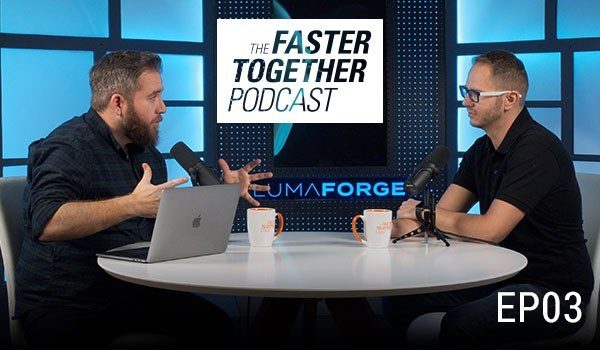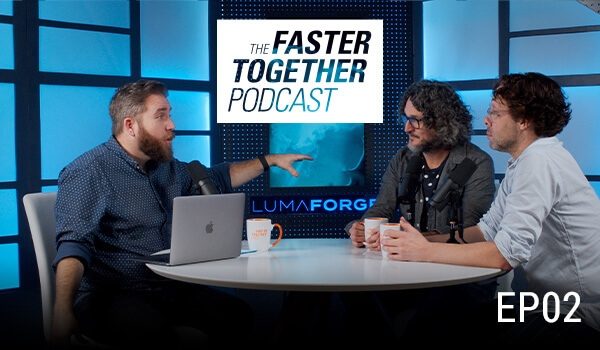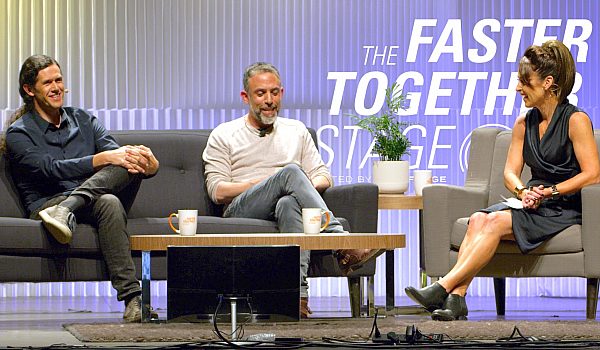Alex Lindsay from Pixelcorps teaches live streaming in a nutshell. What are the things you need to know when going live for YouTube, Facebook, or broadcasts for network television? Alex Lindsay shows you how to live stream on small, medium, and large budget productions.
Wwe started doing live streaming, actually not to do live streaming. We were trying to teach classes. So we had, we were trying to, how do I teach 2000 people in 40 countries how to do visual effects, which is what we started in. Uh, my background was Lucasfilm and ILM. And so we were, we went, we figured we could teach everybody how to do visual effects. Um, and, uh, while I wasn't really good at doing the business model of training, I was, there was a lot of people that were like, Hey, that's the live stream looks great, you know, and so, so, so the, so anyways, so it's our business kind of just organically, once one we did a little less of one and did a lot more of the others. So the pixel core right now as we do about two to 300 events a year, that is in every continent except for Antarctica.
Um, typically on any given quarter where somewhere on any of those continents, uh, 90% of our work has government agencies in fortune 50. And the reason I'm giving you these is just to set like where I come from when I look at live streaming, cause it's definitely um, a very distinctive view. 10% is entertainment, music games, television, film, film launches, album launches, um, you know, festivals, that type of thing. And we have a 99.7% success rate in an industry that runs at about 20% failure rate. So, um, and the reason that, the reason I put that there is specifically because when I talk about this stuff, a lot of this is really coming from, you know, kind of an obsession for most of our clients because again, we're doing fortune 50 most, most of our clients, the most expensive thing is failure, you know, so, so we, you'll see kind of heavy, some of the stuff being somewhat heavy gear, it just because we do a lot to make sure that our streams don't not work.
So anyway, so we'll talk a little bit about, um, that process. Um, to give you an idea, I kind of broke the pipeline, the livestream pipeline into four food groups for you to think about. So a, the pipeline really starts with event production. So you have show design and talent, scripting, coms staging, lighting presentations, that is a part of your livestream and a lot of times you come in and you're just covering something and that's a really difficult place when you don't know the other parts or if those other parts aren't managed. Um, if you're not in communication, if the stage just starts doing whatever it's going to do and you have no idea what's going on, if they're not ready, if they don't give you your space in time, if you don't, you know, there's, there's all kinds of things that go wrong. So understanding that that is really part of your live stream is, is important.
Um, and sometimes it's just gonna be a little, you know, three people and then it's obviously part of your thing. But if you're working in a large conference, um, and putting those things together, that becomes much more of a, of an issue of understanding how that's going to work. Then of course you have the video production, so that's your cameras, your switching for graphics, mikes, all those things. Um, your audio mix, captions, captions are becoming more and more important. Piece of our job. We went from not doing any captions probably four years ago to a captioning job a week. Um, and that can be done through web interfaces, uh, using something like stream text, but it can also be done through, uh, you know, hardware there. You know, we use a EEG four 92 to tie that into the SDI, which then gets encoded, which then shows up on YouTube and now Facebook and a couple of other ones.
The a transmission is how you get from where you're at to the internet. And that can oftentimes be a couple of different things. So local is like, I have an encoder here. I found an internet at the hotel. Um, satellite is obviously sat trucks. Five years ago, I just thought the sat trucks were kind of the cool thing that I walked by. Now we'd go in and look at all the dishes and look at what wood coders they're using and everything else. Cellular is a bonded cellular solution. So those might be Abby West or it might be live you a Dejero. Those are all bonded cellular solutions. You can roll your own with pep waves. And then fiber. And when I'm talking about fiber, I'm talking about specifically video fiber, which is the civics or the switch. Those are the two. Really the two primary Vivek is level three, the switches, its own thing.
It's up on, uh, in the South hall and then finally have a CDN players. So that could be Facebook, it could be YouTube, Ustream companies like [inaudible] studio provide white labels for large corporations. So there's, there are, but there's, you know, 50 of those, but those are probably some of the largest ones. Facebook and YouTube, uh, probably account for 95% of the public streaming that's out there right now. Specifically what we do is the first three. So we really depend on someone else to do the CDNs. So that's what I'll be really talking about more than anything else. But I'm happy to answer questions about the other ones as we move forward. Um, so the first one, let's talk a little bit more about event production. So one of the things that you want to think about is why are you doing a live stream? I mean, and this is really a, uh, a key factor because a lot of people live stream stuff that they shouldn't.
Um, live streaming is stressful. It is high risk. It puts the brand at risk if it's all kind of, you know, there's all kinds of reasons to not live stream. So for us, there's really three reasons that we feel like live streaming becomes appropriate. Uh, one is a news event. So something is happening right now that you want to show the rest of the world. Another is sports obviously cause we to know the score, we want to enjoy it and not know the score. Uh, and then interactivity. So finding ways for your online audience to ask questions who are streaming this. For instance, we, you know, if we streamed it to Facebook live, we figured out how to get the comments back in. So the people who are watching online can, can, you know, ask questions and we can answer them during the, you know, during the event.
Those types of things is, is really the thing for us. Those are the three reasons. Now there are a couple other reasons of leveraging the way promotion works on Facebook and then so on and so forth. So there are a couple other reasons to do it, but those are the primary ones that I would, um, you know, think about, uh, questions to ask when you're thinking about that process is, you know, who is your primary audience? Who are you streaming this for? You know, why do they think this is important? I mean, and really thinking about why that is. If you can't answer these questions, if you're just like, well, we're just gonna put it on the internet. Like you got to, it defines where you put your camera's. It defines how you know, how you organize the event is when you really drive who the audience is going to watch it.
Are they going to watch it on their phone versus are they going to watch it? On a big screen that changes, you know, how they're gonna interact with it. Because if it's on a phone, our typical framing of waist up doesn't look great. You want to, you know, say literally you start changing things. We now want, we would prefer for our hosts to move less so that we can get closer shots because the closer shots are going to look a lot better on the phone than they will the wider shots, you know? So there's lots of designed processes that we start thinking about. Um, you know, based on that, you know, what is the online audience getting out of this? Why are they watching it live? You know, like what, what is in it for them? If it's just another presentation, a lot of times, you know, well they can watch it anytime and they can stop and start and do all these other things.
So you really want to think about what gives them a reason. And that can be interactivity. It can be the fact that they're all watching it together creates a kind of a, a community effect. And then how do we leverage opportunity? Which means really if you're at a conference, leveraging the opportunity of NAB to have a little room here. So how do you get advanced? The advantage of all is who will be in the same place at the same time. That's oftentimes a great reason to do it. So some event tips, learn from broadcast, broadcast. Actually, you know, they do this pretty well. So, so we, you know, we want to be internet and we want to think about all those things, but it doesn't hurt to watch how a broadcast network puts together a live stream and really think about what they're doing there.
And now as you do more of them, you'll start to get it. But, but really thinking about, you know, what is, um, you know, how are they getting out of this segment? You know, cause those are the things getting in and out of your events is one of the hardest things to do. Well. So how are they getting in? How are they getting out? Oh, they're throwing, you know, they've got a sweeper and then they've got this lower third, and now they're gonna throw it to this person and they're going to grab that. And, and there's a lot of people spending a lot of money on that. It doesn't mean you have to do everything that they do, but it does help plan early, live to the web. Oftentimes it's seen as let's, uh, stream this, you know, uh, you want to really, you know, the best way to do it is really throw resources.
The more you get ahead, the easier it's going to be as you, as you start to work through it, uh, rehearse a lot. Usually what we really spend a lot of time rehearsing, obviously if there's a lot of slides and back and forth, we'll rehearse that. If one of the big things for us is that we really rehearsed the opening and the closing of our event over and over and over and over again until it's bored in a boring one. Our crew was bored of it and they're like, Oh my gosh, we have to do it one more time than you're about ready. Then just do it twice more, you know? So and then, yeah, two more. Like when they're, when they're bored, when they're angry that you're doing this again and they, they, they're hungry. That's just due to twice more and then you'll be sad, you know, but, but you really want to know that, you know, there's a lot of times, especially for a large stage event, there are a lot of cues, you know, you're going to say, you know, lights go, you know, music go liquid three go.
We have a, you know, getting, you know, is it all these little pieces and everybody has to do their little part to have it all come out at the same time. You know? And then as I was mentioning before, think of how it looks on a phone as we continue to go down live streaming a larger and larger group of people are watching this on their phone. Um, so when you think about your lower thirds, your graphics, your sweepers, can they read that text? Because a lot of times they can't. So you have to really think about how your texts looks, how people are framed. Everything gets really driven more from a, a phone than it does from the, from the desktop experience. Here's what will get you in the event, making the event too complex for the budget. So, you know, deciding you want to do this big thing, but you only got this much money, you know.
Um, we, a lot of times what we say for within our company is keep your elbows in. You know, when you're, when you're thinking about this. And I used to wrestle, so there was a big thing of, you know, guy would get out a little too far and you'd reach out and next thing you know, you'd be going up in the air and then you'd be on the ground and then you'd be pinned. So, um, that's what happens when you get pinned in live streaming. There's, you know, a lot of unhappiness. So, uh, so let's just say it's bad. So, um, so you know, a lot of times when you're working on this, you just really want to, you know, think about keeping the, keeping your elbows in and really doing what you can do with what the, with the money and the resources that you have.
Also on the other side of that is thinking small, like only thinking about what you can do that, Oh, we're just going to turn one little camera on. You know, it does help to think like of where you could go with it. Just make sure that that's within a range of, of something that you can do well. Um, lack of preparation and speakers, the, the number one reason that you'll, your event will start late is because your speakers aren't on time, you know, you know, so I mean, that is the, the number one, uh, reason that they, and then there'll be jostled and then they won't be ready and they didn't rehearse and they, so speaker's not being ready and then lack of preparation for how you're going to get through any kind of tricky transition. Those are the things that'll get you the schedule.
You know, so a lot of times people like have an event where they schedule everything so tight. They're not thinking about the fact that there needs to be breaths to get from one thing to the next. You know, and a lot of times if we're doing live streams, we throw VOD, you know, we throw some, some, some playback ends so that, you know, I've got a three minute piece that's going to give my whole crew a minute to like stretch out again and then come back in. So thinking about that schedule, but if you just have, it's all live, all live, all live, all live and it's packed to the Hill, um, it gets you into trouble really quickly because you have nowhere to go if you get behind. Lack of coordination with the live team. And what I mean by that is if you're at an event that's being managed by somebody, lack of connection with them, um, causes a lot of problems because they're just doing their own thing.
And you always have to remember that the folks doing the live part don't care about you at all. When you start that way, then we all understand where we're at. So, um, you know, cause I, I didn't put it in here, but the most important thing with, with production and in life and I would say is knowing where you are in the food chain, you know, and uh, and so, um, now live streaming is going more important. When we started, we were plankton, you know, you know, and, uh, and we've moved up, we moved up to like a dog shark, you know, not really, not a lot of teeth, but, uh, you know, it's still there. Um, and then prioritizing the in-room too heavily. So thinking too much about the in room experience as we moved to where livestreams are going from being 10% of the live of the, of the room to 1000% of the room or 100000% of the room.
We need to really think about this as a TV show. You know, where we put our cameras is where we S you know, like when you know that you're gonna have a lot of viewers, you stop thinking about where you put your cameras. When you go to a big event like the, the, the MES or, or the, you know, the Grammys or whatever, they're putting the cameras where they want to put the cameras, you know, like, like they, they, their seat kills, their seat kills, you know, and that's because they know that there's a vast, the vast majority of yours are outside of the room. So video production, there's a lot of different scales. Um, obviously you have your phone zero to a thousand dollars. And what I mean by that is that you can just take your phone out and start streaming at this point.
But you can also get, you know, an interface for your audio so you have a lightning to, or a heads headphone to, you know, a interface. So you can get XLR in, you can attach wireless mikes to that and you can touch a light, you can hook it to the ethernet. You can, you know, so it, you know, the phone can kind of build up webcam based. It can be, you know, you throw a better webcam and a and a better mic on it and you can start to start to do stuff. Um, to make that useful. We've, we have put little control, you know, like put little webcams onto things we can hand hold and walk around in and stuff like that. Small camera systems, which are, we're starting to get into little micros. Um, you know, you know, micros are a great um, tool for that.
Um, but that they'll start to add up. You know, now you're talking about hardware switchers and in bits and pieces, but that, that's the next step there. Small studios, 15 to 75,000 is kind of your range as we start to build it. If I want to do this all the time, full studios started about 75, booked about a half million and then event production is just per, yeah, I can't even tell you. I was like, it's just, they can be small numbers like five or $10,000. They can be big numbers that are, you know, big numbers, some production tips, a overbuild for your budget. So when you think that you're going to do something, try to add a couple extra things to convert sync, convert files, you know, extra records, you know, a little bit of extra of everything. So you budgeted and you said, this is what I need.
And then if you can figure out a way to add a couple more, a couple of little more bases in there, an extra camera and extra whatever, uh, you know, having just a little bit more, it gives you that space to handle things that you don't expect. And it just makes you look good because you pull out another camera and you didn't think, you know. And, and these cameras now, the Blackmagic cameras we have of different sizes, we probably have 35 of the black of cameras from the mini minis to the micros and, um, and they're, you know, the cost is incredible. You know, you can really put on a show with them with the mini or micros, the Mike [inaudible] too. But the micros, you can put on whole shows with those, prepare and test the hardware. I just say that because a lot of people just show up with their hardware and then they don't know and then, Oh, this didn't work or this didn't, this isn't recording or whatever.
We build everything in our, we build everything before we'd come to an event. We build it in the, in the we, it's all built and tested days before and then put it into a pack marked as this is a complete set and then it's ready to go. But we don't show up figuring out whether it still works or not. Lots of redundancy, redundancy, redundancy, redundancy, redundancy, you know, backup to the backups. Generally have backups to almost everything we bring. Um, we have, uh, extra encoders extra and we have backups. We almost never stream where we don't have two ways out. We always have a, you know, whether it's, uh, the local bandwidth, but then we'll have a live view that backs that up or we'll have a microwave out and then level, have a live view, the back set up or we'll have, uh, you know, we'll have something that two ways out to make sure that we can always get there.
The backup, we've probably dropped the backup five or 10% of the time, but that's a lot. Uh, labor versus equipment costs. A lot of people save a lot of money on buying, not very much equipment and then they spend a lot of time putting it together and getting into work. Um, there is a, if you're gonna do, if you're gonna turn this into a business, having the right equipment that costs a little bit more will save you in time over and over and over again to, you know, and help, help make that work. So it's worth investing in, not necessarily not the best thing in every little section, but, but definitely, um, invest in the right stuff and just always remember that generally failure is your largest expense. If you're doing it on your, for yourself, it's not a big deal. But he started doing for a client, you know, and it makes them look bad.
You know, when they, you know, when it doesn't work, what will get you is a basing your team and your system to the exact spec that you, that you laid out. So you bring just the number of people that you need. You bring just the, you know, just the equipment that you need and you will get caught because something isn't going to work. Something isn't working the way you expected. The map is never the territory, you know, and, and you're gonna need to react to it. We always have, you know, people to handle that stuff. Uh, lighting is something that hurts a lot of livestreams pretty quickly. Uh, live doesn't like, uh, dark things, so, so, uh, so it tends to not, not be as good that way. Um, short setup times, um, you know, really know how long it takes you to put your gear together and what it's going to take to make that work.
Generally, if you're promoting to a lot of people that you're starting at a certain time, you really want to start at that time led walls behind your people, uh, is the devil. So that's all, that's all I'm going to say. The devil audio is the thing that gets most things not having good audio people can watch a really bad live stream as long as it sounds good. You know, if the audio is clear, they can sit through a lot of bad video, but if the, if the audio is not there, uh, they will leave almost immediately. You know, people will not listen through. Like the most common is like ground a ground loop, say a little buzz that you hear that will slowly drive a lot of people. Crazy transmission. We talked a little bit about it here and there. Um, so you know, you have local end code, cellular, satellite fiber.
These are all ways to get out of your space. The most common, of course, our local plus cellular. Um, but if you're getting serious about it, always think about two ways out. Um, and then, you know, obviously the encoding trends that we're seeing for live streaming, uh, one is uh, you know, interactivity Q and a is figuring out a way to get questions from the online audience, mobile people streaming from their phones, um, is a, is definitely a trend for K and three 60 was on the other end of that. People wanting to stream three 60, multi-camera three 64 K, that type of thing. Conferences, a lot of people are streaming their conferences, not all of them, but a lot of them are. What we're seeing as a trend that's coming is conferences, streaming everything, every room, every process, everything, but then curating that conference as well. So having one channel that's really great, that's the switch between everything and studios and Rowlands and stuff like that that you could put up on Apple TV and just let it run. So those are the, you know, those are the different, those are the two things that we see with conferences. Is that like, let's dream at all, but let's have one channel that looks great and that's it.


 Mobile
Mobile
 Tower
Tower
 R24
R24
 Builder
Builder
 Manager
Manager
 Connect
Connect
 Kyno
Kyno
 Media Engine
Media Engine
 Remote Access
Remote Access
 Support
Support



